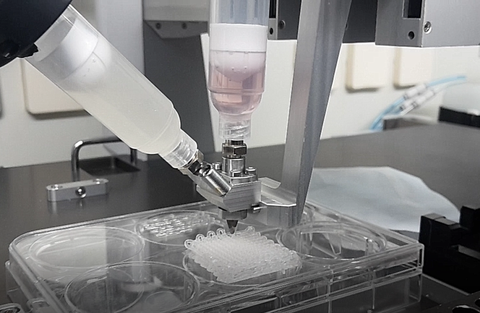Jan 27, 2022
Taking off with bioprinting into space

Bioprinting von zwei verschiedenen Zelltypen und Materialien in einem Konstrukt unter Verwendung einer Koaxialdüse
TU Dresden leading in Europe concerning utilization of 3D bioprinting in space
In recent years, a whole series of spectacular space missions such as robot landings on Mars and on the far side of the Moon have taken place, impressively demonstrating the technical possibilities that are now available. This opens up new perspectives for crewed missions, initially to the Moon (on which astronauts last landed in 1972), but later also to Mars. In order to keep the risk for the astronauts as low as possible on such very long expeditions, the international space agencies are intensively researching to develop systems that are independent of the Earth and can be used in the event of technical and health problems. While crew members on the International Space Station ISS can always return to Earth at very short notice in the event of an emergency, this is not possible on a Mars mission for various reasons, such as the orbit mechanics or the available resources.
Additive manufacturing processes, often referred to simply as 3D printing, play a central role in such emergency systems. In the technical area, on the one hand, large structures can be created using the resources found locally and, on the other hand, spare parts for spaceships or ground vehicles can be produced quickly and flexibly. But 3D printing can also help when serious health problems arise, for example in connection with an injury. This is where the so-called bioprinting comes into play, which describes the three-dimensional printing of living cells into tissue-like constructs. The Centre for Translational Bone, Joint and Soft Tissue Research – a central scientific facility of the University Hospital and Faculty of Medicine of TU Dresden under the direction of Prof. Michael Gelinsky – is one of Germany's leading and internationally successful laboratories in the field of bioprinting.
Commissioned and financed by the European Space Agency ESA and together with the Bremen-based space technology company OHB, the centre began investigating the possible use of bioprinting in space missions in 2018; a completely new topic at that time. In addition to the production of replacement tissue, for example for the treatment of severe skin injuries or complex bone fractures, bioprinting can also be used to create very defined tissue models on which, for example, the influence of space conditions such as weightlessness and cosmic radiation on cells and tissue can be examined on the ISS. In order to open up this possibility to scientists for basic life science research and to further research the use of bioprinting in space medicine, ESA has now decided to build a 3D bioprinter for the Biolab in the Columbus module of the ISS. This should be available there for experiments from 2025. Meanwhile, ESA declared the bioprinting lab of Prof. Gelinsky and Dr. Anja Lode in Dresden to become an "ESA Ground-Based Facility", which gives European researchers the opportunity, supported by the ESA, to carry out preparatory investigations in Dresden with the excellent equipment available and advised by the experts there.
In order to further raise awareness of these developments and opportunities internationally, ESA, the German Space Agency at the German Aerospace Center (DLR) and the TU Dresden will be holding a workshop on "Bioprinting in Space" in Dresden on March 15th and 16th. This is intended to facilitate the exchange between astronauts, bioprinting experts and specialists in the field of life science research in space and to stimulate experiments that are necessary to prepare for the use of bioprinting technology on the ISS.
An in situ skin printer has meanwhile already found its way to the ISS: a device commissioned by DLR and built by OHB, with which a cell-containing hydrogel can be applied directly onto a wound to accelerate healing, is being tested by Matthias Maurer with model materials during his current six-month stay on the ISS. The associated ESA space mission bears the beautiful name "Cosmic Kiss". Professor Gelinsky from TU Dresden is involved as a scientific advisor from Earth.
Information about the workshop: https://tu-dresden.de/med/tfo/wbisdd22
Contact at TU Dresden:
Prof. Michael Gelinsky
Head of the Centre for Translational Bone, Joint and Soft Tissue Research
University Hospital Carl Gustav Carus and Faculty of Medicine of TU Dresden
Tel.: +49 351 458-6695 (secretary: -6694)
For further reading:
N. Cubo Mateo, S. Podhajsky, D. Knickmann, K. Slenzka, T. Ghidini, M. Gelinsky: Can 3D bioprinting be a key for exploratory missions and human settlements on the Moon and Mars? Biofabrication 2020, 12, 043001. https://doi.org/10.1088/1758-5090/abb53a
